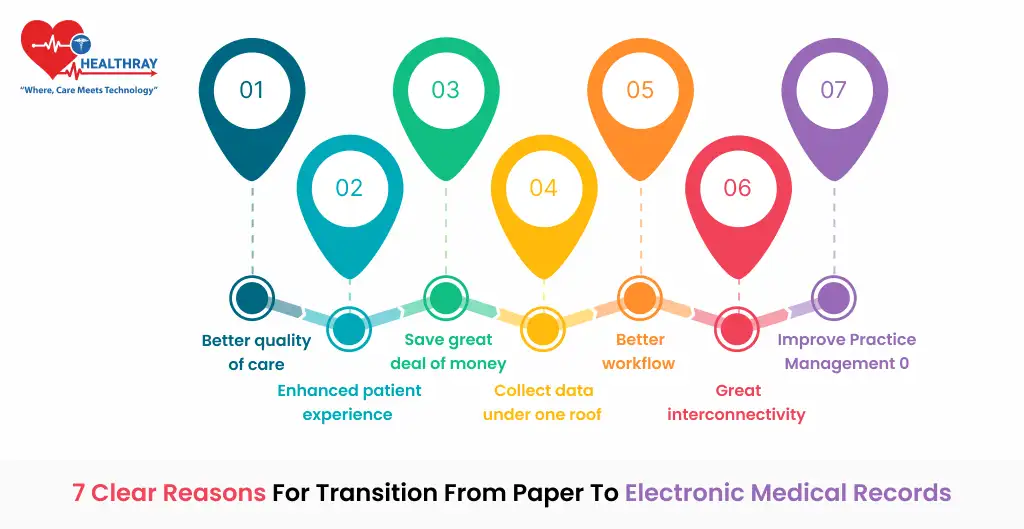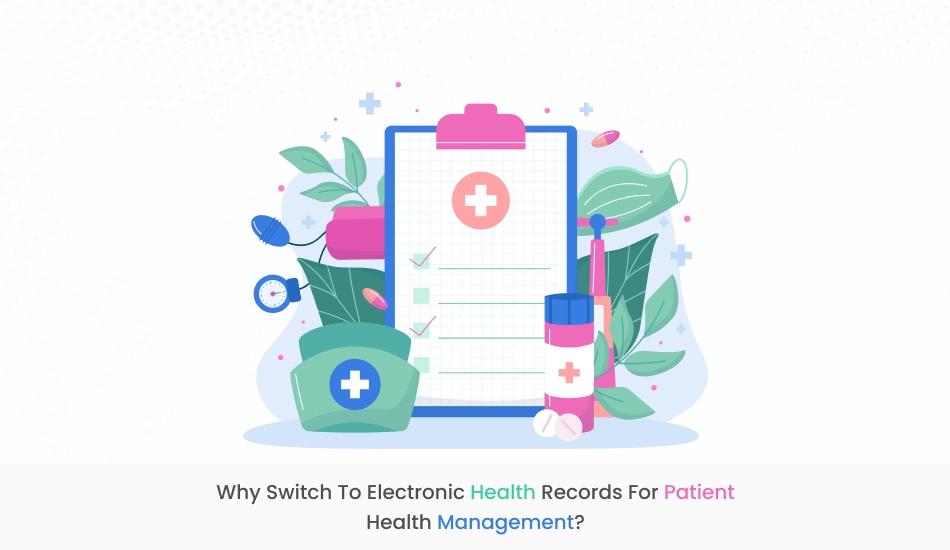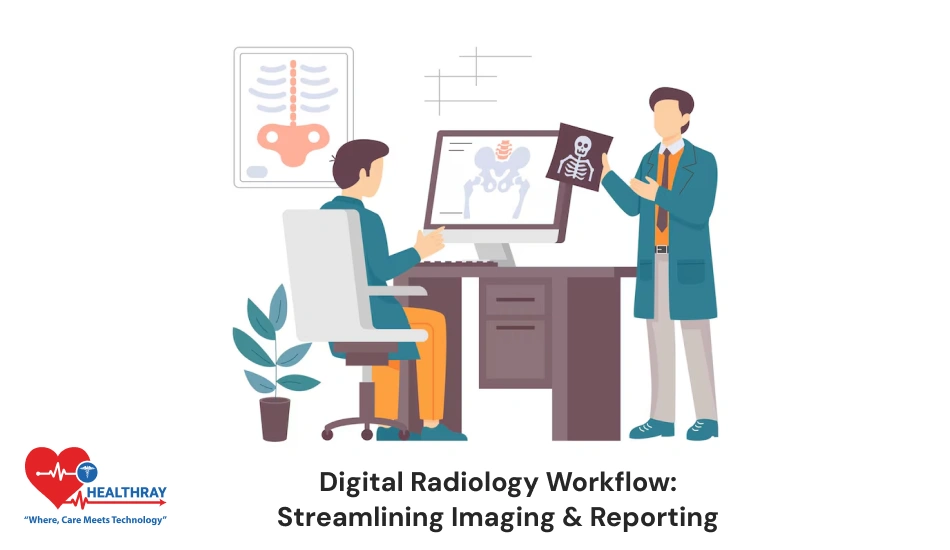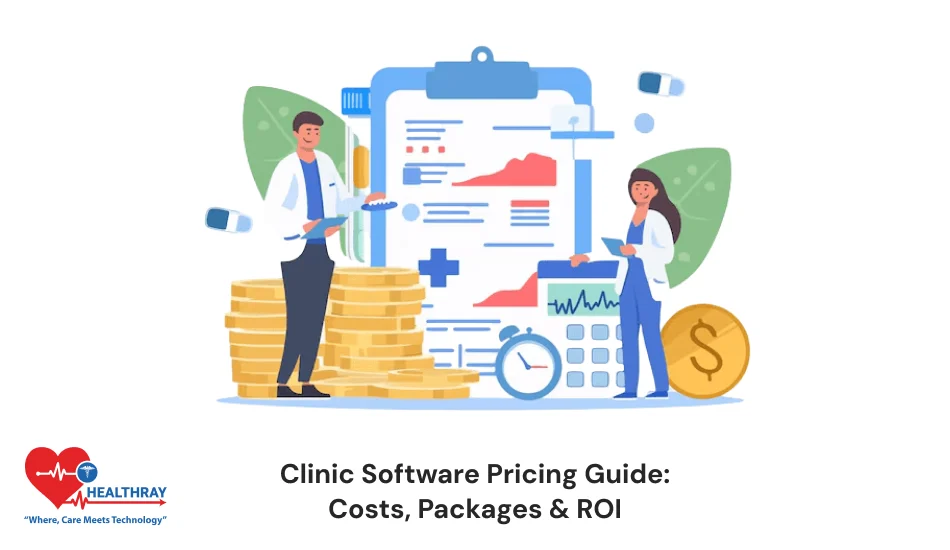Quick Summary
By digitizing medical information, expanding accessibility, improving supplier coordination, diminishing mistakes, and empowering superior patient engagement and results through data-driven experiences and compelling communication, the selection of Electronic Health Records (EHR) speeds up the administration of patient well-being.
Introduction
Exact surgery is just one perspective of technological improvement in the medical division; there are other procedures included as well. Presently, the majority of patients are accustomed to seeing their medical experts enter notes onto computers during office visits, in spite of the fact that the healthcare division has taken a lot longer to move from paper-based to advanced systems.
However, in order for hospitals and clinics to truly benefit from EHR Software Solution, they are required to go beyond basically entering fundamental patient information into frameworks, turning that information into an essential component of managing patient care across the board.
One of the most prevalent subjects right now is completely digitizing the healthcare framework. You are, without a doubt, mindful of the push to utilize electronic health records if you need help understanding why it is an excellent thought to make the changeover. In this post, we’ll talk about the preferences for utilizing digital innovations in medical practice. Let’s walk through the guide of transition from paper to electronic medical records.
What are electronic health records?

A patient’s paper chart is carefully protected in an electronic health record (EHR). EHRs are patient-centered, real-time records that grant authorized clients fast, secure access to data. An EHR framework is designed to go past the everyday clinical information collected in a provider’s office and can be comprehensive with a broader view of a patient’s care. However, it does contain the medical and treatment histories of patients. A great EHR system might include:
- Incorporate data on a patient’s health history, conclusion, medicines, plans of care, dates of immunizations, allergies, radiological pictures, and laboratory and test results.
- Give healthcare experts access to evidence-based assets so they can choose how best to treat patients.
- Streamline and automate the supplier workflow.
As more patient information becomes computerized and more clients express a desire to have mobile access to their health records, the work of EHRs is becoming more and more critical. The next improvement in healthcare that can improve the compatibility between specialists and patients is electronic health records (EHRs). Superior judgments and care will be able to be made by suppliers thanks to the data’s timely availability.
What are disadvantages of paper-based records?

Lack of storage space
Paper records have a number of disadvantages, chief among which is the constrained amount of storage space they require. Physical document collection can quickly take up invaluable space inside a company. Expanding paper archives involves the use of filing cabinets, racks, or particular rooms, which increases the cost of infrastructure and space administration.
Besides, as the volume of paper records increases, organizing them might become more troublesome, which can result in wasteful administration and recovery. The challenges of keeping traditional records are by the frequent stress about losing or misplacing documents.
Furthermore, physical harm from components like water, fire, bugs, or weakening over time can influence paper-based reports. Constant attention and budgetary investment are necessary in preventive measures to guarantee the assurance and conservation of these records.
These restrictions show the impediments of utilizing paper-based records as they were for data administration in a progressively digital environment.
Security issues
Since traditional records are effortlessly stolen, lost, or have access by parties, they give genuine security issues. Paper papers are inherently susceptible, in contrast to electronic records, which may get damage and defend using advanced security strategies. Sensitive data breaches may result from physical misfortune or scattering of paper records, which might expose monetary data, individual health data, or other private reports.
Strict rules for access control, capacity, and transfer are also essential to protect the security of paper data. Still, they can be troublesome to actualize consistently over distinctive offices or areas. Natural disasters like fires and surges can also hurt paper documents, which may lead to the irreversible loss of vital data.
The security dangers associated with paper-based records highlight how basic it is to switch to Electronic Health Records, which give improved security features and assurances to keep private data secure from breaches or undesirable access.
Prone to damage
One of the main drawbacks of paper-based recordkeeping is their susceptibility to deterioration. The elements—which include heat, light, moisture, and insects—damage paper documents quickly. When exposed to these conditions, the information contained in the records may fog, rip, discolor, or, in the case of an address, completely vanish.
Moreover, misplacing or mishandling missing paper reports could potentially escalate the risk of injury. If records are stored in a crowded or disorganized capacity zone, they may spill, wrinkle, or turn more frequently. Touching paper documents also frequently increases the risk of deteriorating over time, which seems to compromise the accuracy and consistency of the data they contain.
Paper-based records are more likely to have data errors or mishaps, which can complicate the long-term preservation of those documents and have serious implications for healthcare organizations regarding patient care, compliance, and legal obligations.
Document transportation
One major downside of paper-based record transportation is that it can be troublesome and incapable. Paper records are required to be physically transported from one place to another, in separation to electronic records, which are quickly transmitted and recovered remotely. This methodology can take a while, particularly if reports require to be moved over work situations, divisions, or healthcare facilities.
Paper record shipping entails additional risks, like theft, mishaps, or injury while in transit. Patient confidentiality and protection are undermined by the fact that security barriers and records are still lost or decisions are reached without sufficient consideration.
Furthermore, it might be a laborious process to coordinate the transfer of paper records from one range to another. This is because resources for pressing, mailing costs, dispatch companies, or staff members for delivery will be required. These uses could eventually accumulate and raise the standard operating expenses associated with keeping paper-based record systems.
All things considered, the requirement for the true generation of paper records is a significant drawback when contrasted with the sufficiency and comfort offered by electronic health record frameworks.
Editing problems
Paper-based records have a number of disadvantages, one of which is altering challenges. Paper records are more reasonably prone to change than computerized data. Manual consideration is basic for any upgrades or changes which might result in mistakes and wasteful aspects. This control becomes particularly troublesome in settings where it’s vital to make upgrades or alterations routinely, like medical records or lawful paperwork.
Additionally, changing paper-based data takes a portion of the exertion and is routinely error-prone. Comments or changes made by hand can be troublesome to study or misjudge, which can cause error or false data. Paper records may, too, be have duplicates, which makes it tricky to ensure that all adjustments are up to date.
Besides, the possibility of blunders and irregularities between a few adjustments of the same report is in traditional frameworks due to the absence of form control. These adjusting issues bring to light the disadvantages of keeping paper records in progressed, excited settings where availability, reasonability, and exactness are crucial.
7 Clear Reasons For Transition From Paper To Electronic Medical Records

Better quality of care
There are various benefits to utilizing electronic health records (EHRs) instead of paper-based systems, which can in the long run result in higher-quality care. To begin with and foremost, EHRs improve accessibility and help information recovery, guaranteeing that healthcare providers can appropriately and rapidly access patient information. This helps decision-making in crisis circumstances or gatherings, upgrading reaction times and patient outcomes.
Second, by allowing medical staff to enter serious and well-organized patient data, EHRs enable cautious recording. It engages more precise assurance and individualized treatment strategies by combining medical histories, lab discoveries, solutions, and treatment plans.
Electronic Patient Management System also offer assistance to healthcare teams in communicating and working together, encouraging the simple sharing of patient information among different divisions and specialists. This multidisciplinary strategy advances integrated care, brings down the chance of mistakes, and guarantees that patients receive all-encompassing care.
Additionally, compared to paper reports, electronic records are more open to review and more secure, reducing the possibility of data misfortune or breaches. EHRs give a solid establishment for giving exact, helpful, and patient-centered care, which makes them a superior alternative for medical workplaces looking to maximize their offerings.
Enhanced patient experience
Patient experience is one of the top priorities when you are dealing with the healthcare industry. Compared to ordinary paper-based records, electronic health records (EHR) have numerous benefits that incredibly improve patient involvement. First of all, EHRs expedite authoritative procedures, cutting down on printed material and waiting periods. Instead of wasting time on inconsequential printed material, patients spend more time connecting with medical professionals.
EHRs also move forward communication between healthcare providers, ensuring that patient information is current and accessible over divisions and locations. The smooth compatibility of information results in better patient outcomes by advancing more individualized and facilitated care.
EHRs, moreover, improve security by bringing down the possibility of mistakes brought on by ineffectively readable handwriting or lost paperwork. By counting built-in tests for hypersensitivities and pharmaceutical intelligence, electronic gadgets decrease the chance of unfavorable outcomes.
EHRs also engage patients by giving them access to their medical records, which empowers them to take a more dynamic part in their claim care and make well-informed choices about their course of treatment.
The switch to electronic health records not only increments efficiency and precision but also progresses patient fulfillment by encouraging empowerment, security, and communication.
Save great deal of money
There are a few benefits to utilizing electronic health records (EHRs) instead of traditional frameworks, chief among them being cost decreases. To begin with, Electronic Health Record System result in significant long-term savings by doing away with the need for paper, printing, and storage costs related to conventional records. Electronic records also diminish labor costs associated with labor-intensive manual information input, recording, and recovery obligations by streamlining regulatory tasks.
EHRs, moreover, help to progress the effectiveness of healthcare conveyance by encouraging speedier access to patient information, diminishing test duplication, and minimizing mistakes caused by misplaced or messy handwriting. Progressed patient care and fulfillment are a direct result of this productivity.
EHRs moreover encourage interoperability, which reduces the requirement for unnecessary tests and medicines and, in conclusion, saves cash for the healthcare framework by facilitating the smooth sharing of patient information among healthcare providers.
In conclusion, utilizing electronic health records is a wise investment for healthcare suppliers since it lowers regulatory and capacity costs, increments proficiency, improves patient care and advances interoperability.
Collect data under one roof
Utilizing electronic health records (EHRs) instead of paper-based frameworks offers numerous benefits. One of these is the capacity to assemble information in one location. Comprehensive and all-encompassing patient care is achievable. This is by consolidating patient information from numerous sources into a single, one platform for electronic records.
Healthcare experts can successfully collect and organize an assortment of information. They achieve this with the utilization of EHRs, including medicine records, test results, medical histories, and treatment plans. A more intensive picture of each patient’s health status is conceivable by this information repository, which moreover enables medical staff to make more better clinical decisions.
Electronic records, moreover, make it simpler to recover and update patient information, which brings down the possibility of mistakes and ensures that medical experts have moment access to the most recent data. The guarantee of continuity of treatment over different healthcare settings not only increases effectiveness but also progresses patient security and satisfaction.
In conclusion, utilizing electronic health records gives medical experts the capacity to assemble and handle patient information in-house, which promotes expanded efficiency, more educated choices, and superior patient care.
Better workflow
Workflow productivity can incredibly increase by exchanging from traditional frameworks to electronic health records (EHRs). Electronic health records (EHRs) mechanize these steps. This improves workflow management.
Healthcare suppliers may input, access, and update patient data with a few clicks. This utilization of electronic records saves time and exertion on regulatory exercises. Healthcare suppliers can concentrate more on giving high-quality care. This happens when operations like patient enrollment, appointment planning, and invoicing are more rapidly happening, enhancing productivity.
Furthermore, integrating innovations like updates and clinical decision support frameworks are regularly in EHRs. These tools encourage clinical workflows, improve patient checking, and increment adherence to best practices and guidelines.
Electronic records make it simpler for individuals in the healthcare group to collaborate and communicate with one another. This speeds up referrals, meetings, and care coordination.
In conclusion, the selection of electronic health records leads to improved workflow administration. This, in turn, improves patient care conveyance, increments operational effectiveness, and eventually enhances overall healthcare results for healthcare suppliers.
Great interconnectivity
Electronic health records (EHRs) are a better choice for modern healthcare frameworks. They provide unmatched interconnectivity when compared to paper-based records. EHRs encourage seamless participation. They empower healthcare suppliers to share patient information over offices, facilities, and geographic locations.
Regardless of their physical area, healthcare specialists may immediately access detailed patient records due to the interconnecting of EHRs. This speeds up decision-making. Lowering the possibility of mistakes is crucial. It ensures coherence of care, especially in crisis scenarios or amid patient exchanges between different healthcare offices.
EHRs also encourage secure information transmission and communication between heterogeneous frameworks by supporting interoperability measures. Interoperability provides a complete and exact view of the patient’s medical history. This increases effectiveness, diminishes repetitive testing and strategies, and improves patient safety.
All things considered, utilizing electronic health records has a few benefits for interconnectivity. It helps healthcare specialists provide more facilitated, successful, and productive care, which eventually results in better patient outcomes.
Improve Practice Management
Practice administration in healthcare settings is incredibly upgrade when you use electronic health records (EHRs) over traditional records. EHR frameworks come with plenty of features and tools. These aim to improve efficiency, simplify regulatory obligations, and optimize practice operations as a whole.
Automated appointment planning, which reduces staff workload and minimizes planning errors, is a significant advantage of EHRs. Moreover, smooth billing and coding strategies made conceivable by electronic data advance faster repayment and better income cycle administration.
EHRs make patient charts, medical histories, and treatment plans effectively available. This empowers healthcare experts to give more viable and individualized care. Also, easier transitions of care over different scenes and suppliers are conceivable by this accessibility.
EHRs frequently come with analytics and detailing features. Professionals can use these features to screen important performance markers. They can also pinpoint areas for advancement and make data-driven choices to improve patient results and office efficiency.
In conclusion, utilizing electronic health records helps oversee the practice way better. It streamlines authoritative work, improves patient information accessibility, and advertises quick information to maximize proficiency.
Make the switch to EHR systems from Healthray for better record-keeping!
For prevalent record-keeping, move from Healthray to EHR systems. The most noticeable EHR software accessible in India is given by Healthray. This guarantees a basic and reasonable way to oversee patient data. Healthcare providers can digitize and centralize records with Healthray’s EHR Software Solutions, empowering faster recovery, more clear access, and progressed security. With Healthray’s EHR program, you can wave goodbye to difficult paper-based systems and welcome comfort and constancy. Make the alter directly for way better patient care, prevalent record-keeping, and more capable practice operations.
Step towards digital era with our healthcare solution
Revamp your hospital facilities and embrace change for better healthcare management. Ease in managing and organizing large medical datasets leads to effective analysis. Seize the opportunity now!
Conclusion
Modernizing patient health organization requires a shift to electronic health records or EHRs. EHR systems increment overall healthcare capability, speed up record-keeping methods, and advance patient information accessibility. EHRs engage superior, educated decision-making and individualized patient care with features counting interoperability, data security, and advanced analytics. Moreover, utilizing EHR development guarantees smooth patient coherence of care over settings and advances extended collaboration among healthcare suppliers.
In conclusion, the utilization of electronic health records is a noteworthy progression toward improving patient results. Hence advancing healthcare movement, and building a more cohesive and fruitful healthcare environment.





